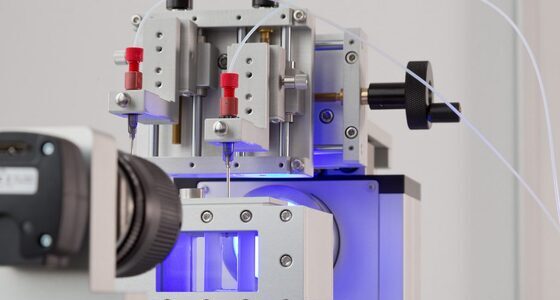Tensiometry
Tensiometry is the measurement of interfacial tension, typically of the interface between a liquid and a solid, gas or another liquid.
Atomic Echo Labs performs dynamic contact angle and force tensiometry measurements using the Dataphysics DCAT21. The DCAT21 is equipped with a high precision balance and z-axis variable speed stage for reproducible measurements of the change in apparent mass of a sample when in contact with a liquid. All measurements can be performed under temperature-controlled conditions from -20ºC to 100ºC.

Liquids
- Surface Tension: The surface tension of a liquid in air can be measured using the Wilhelmy plate method.
Tensiometry
- Liquid-Liquid Interfacial Tension: The du Noüy ring method can be used to determine the interfacial tension between two liquids by measuring the tensile force required to breach the interface.
- Density: The density of a liquid can be measured with high precision by measuring the buoyancy of a solid with well-defined geometry when it is immersed in the liquid.
Solids
- Density: The density of solids can be analyzed by measuring the mass of the solid and calculating the volume by the buoyant force when the solid is immersed in a liquid of known density.
- Dynamic Contact Angle: The contact angle of a liquid-solid interface can be measured by the tensile force applied while the solid is being immersed (advancing contact angle) and withdrawn (receding contact angle) from a liquid with known or measured surface tension and density. Thin films can also be measured in this manner.
Powders
- Density: The density of a powder can be determined by the same measurement as the density of a solid.
- Contact Angle: By treating the interstitial space of a powder as though it were a bundle of capillaries, the relationship between the contact angle and the capillary constant can be determined.
Ideal Uses of Tensiometry
- Characterization of coatings, films, fibers and powders to investigate their hydrophobic/hydrophilic properties
- Investigate changes in surface finish
- Measure physical properties of materials
- Raw materials fingerprinting
- Sample purity determination (potentially in conjunction with other methods)
- Quality assurance and quality control
Strengths
- Non-destructive method
- Surface tension can be measured in many different solvents
- Contact angle and surface tension measurements provide information regarding fluid properties, liquid/liquid interfaces and solid-liquid interactions
- An excellent way to characterize coatings and films; can be used on single side coated samples
- Can be used on fibers
- Density of liquids, solids and powders can be used to track physical properties
Limitations
- Volume requirements:
- For density measurements, sample requirements are 40 mL liquid and ~1 mL powder
- For surface tension measurements, sample requirement is 20 mL
- For contact angle measurements, requirements are: ~20 mL liquid, ~30 mL powder and ~5 mm length of solid material
- Cannot be used on strong acids
Tensiometry Technical Specifications
- Temperature control -20°C to 100°C

